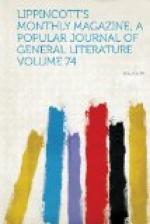Here he died, and entered his tomb in the church himself had founded. Into this sepulchre the emperor Otho iii. dared to penetrate in the year 997, impelled by a motive of vile and varlet-like curiosity. They say the dead monarch confronted his living visitor in the great marble chair in which he had been seated at his own command, haughty and inflexible as in life, the ivory sceptre in his ivory fingers, his white skull crowned with the diadem of gold. The peeping emperor looked upon him with awe, half afraid of the mysterious and penetrating shadows that reached forth out of his rayless eyes. Before he left, however, he peered about, touched the sceptre and the throne, fingered this and that, and having, as it were, trimmed the nails and combed the beard of the great spectre, retired with a valet’s bow. Observing that Charlemagne had lost most of his nose, he caused it to be replaced in gold very delicately chiseled and enchased. The sacrilege was repeated by Frederick Barbarossa in 1165, who went farther and forced Charlemagne to get up from his chair before him. The corpse, in rising, fell in pieces, which have been dispersed through Europe as relics. We saw such of them as remain here at the Chapelle. I was allowed, for about the equivalent of an American dollar, to measure the Occidental emperor’s leg—they call it his arm. And then, as a makeweight in the bargain, the venal sacristan placed in my hands the head of Charlemagne.
I thought Hohenfels would have sunk to the ground with disgust. He colored deeply and dragged me into the air. “I am ashamed of every drop of German blood in my veins,” he cried. “What are we to think of the commerce of these wretches, for whom the very wounds of Caesar are the lips of a money-box?”
I had given back the skull, as Hamlet returns the skull of Yorick to the grave-digger, and was dusting my fingers with a handkerchief, as hundreds of Hamlets have dusted theirs. I said, “’Thrift, thrift, Horatio.’”
“At Kreutzberg there are twenty monks on the counter! This morning, at St. Ursula’s, it was the eleven thousand virgins, their skulls ranged like Dutch cheeses above our heads or in rows around the walls, with a battery-full of them in the neighboring apartment, like a cheesemonger’s reserved magazine. Here, the very leader of modern ideas, the creator of our form of civilization, is shown for so many pennies to any grocer who wants to weigh the head of a king! Profanation! Barbarians! Philistines!”
[Illustration: The skeleton in armor.]




